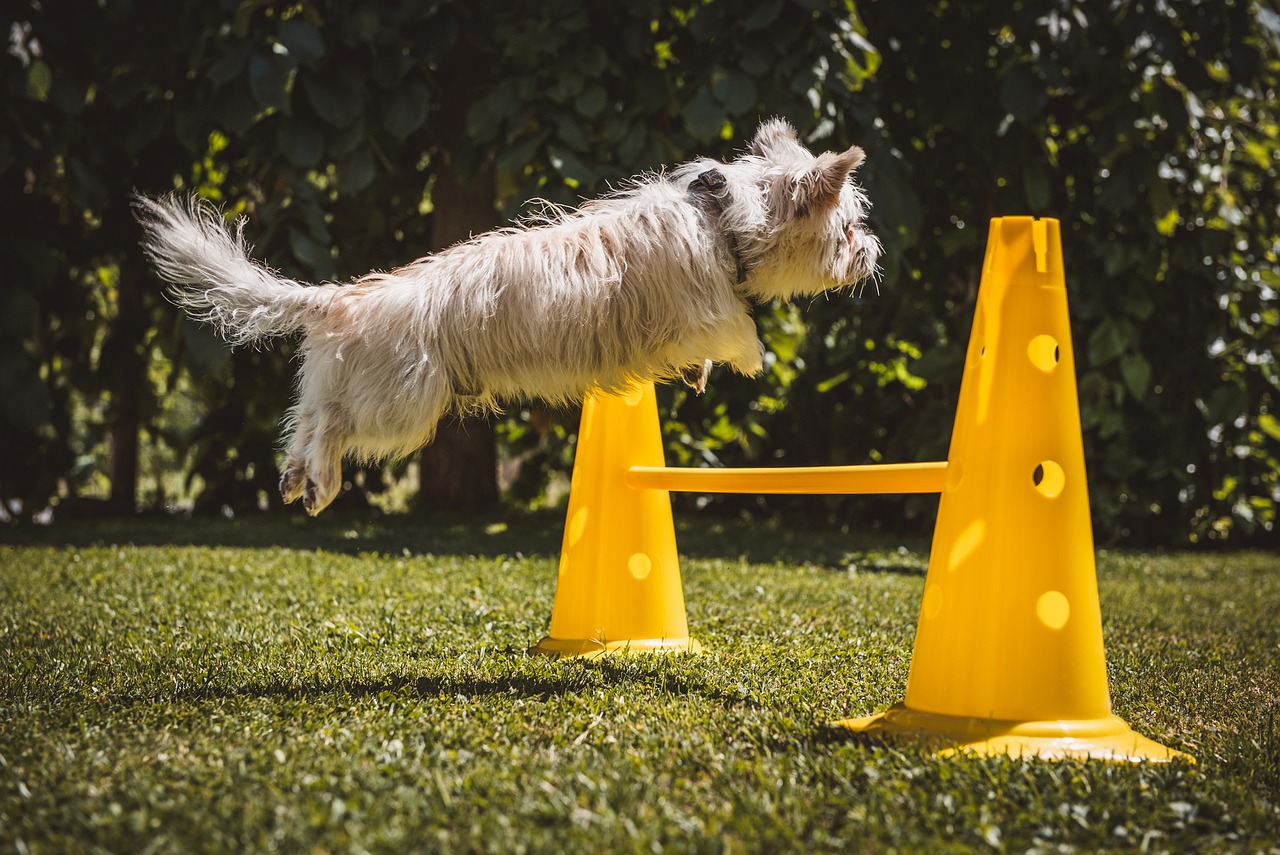Agility training for dogs is a structured sport and exercise activity that is great for a dog’s physical fitness, mental acuity, and obedience. It involves guiding a dog through an obstacle course that tests its speed, coordination, and command responsiveness. Dogs love being competitive and need recreational outlets, and agility training provides an environment that is stimulating for dogs and their owners alike.

Agility Training – What to Expect
- Obstacles
The agility course consists of various obstacles, each designed to practice different skills and techniques. Common obstacles include:- Jumps: Bars or hoops for the dog to leap over.
- Tunnels: Cylindrical tubes for running through.
- Weave Poles: Vertical poles the dog weaves through in a designated pattern.
- A-Frame: A steep, A-shaped ramp for climbing and descending.
- Teeter-Totter: A seesaw-like board that tips when the dog crosses it.
- Dog Walk: A narrow, elevated plank for your dog to walk along.
- Course Design
Agility courses offer varying complexities and lengths, depending on the level of competition or training you are involved in. In competitions, courses are designed to challenge the dog’s ability to navigate different obstacles quickly and accurately, usually under a time limit. - Commands and Handling: Effective agility training requires clear communication between the dog and his owner or handler. Handlers use verbal commands, body movements, and hand signals to direct their dogs through the course. The dog must learn consistency in commands to understand and execute the required actions.
Benefits of Agility Training
Physical Exercise: Agility training is an excellent way to give dogs a full-body workout. It helps build muscle strength, endurance, and flexibility. Jumping, climbing, and running contribute to overall fitness and help manage weight.
Mental Stimulation: Navigating an agility course requires dogs to think critically and problem-solve. They need to remember the sequence of obstacles and react quickly to their handler’s instructions. This mental engagement can help minimize boredom and prevent behavioral issues.
Improved Obedience: Agility training enhances a dog’s ability to follow commands and work cooperatively with their handler. The focus and discipline required for agility can translate into better behavior and responsiveness in everyday situations.
Bonding: The training process fosters a strong bond between the dog and the handler. Working together to master obstacles and achieve goals strengthens trust and communication. It creates a positive and rewarding experience for both parties.
Socialization: Participation in agility classes or competitions exposes dogs to different environments, people, and other dogs. This social interaction helps build confidence and can improve a dog’s behavior in various social settings.
Getting Started with Agility Training
Basic Obedience: Before starting agility training, ensure that your dog has a solid foundation in basic obedience commands such as sit, stay, and come. (Learn more about reinforcing basic commands here.) These commands will help establish control and communication during agility exercises.
Start Simple: Begin with basic obstacles and gradually introduce more complex elements as your dog becomes comfortable and skilled. Start with low jumps and short tunnels to build confidence and avoid injury.
Positive Reinforcement: Use treats, praise, and play as rewards to motivate and encourage your dog. Positive reinforcement helps create a fun and rewarding training environment and reinforces desired behaviors.
Professional Guidance: If you are new to the sport, consider enrolling in agility classes or working with a professional trainer. Trainers can provide valuable guidance on techniques, safety, and course design – or help with attention or behavioral issues if needed.
Safety: Prioritize your dog’s safety by ensuring that agility equipment is properly set up and maintained. Make sure your dog is healthy and fit for the physical demands of agility training. Consult with your veterinarian if you have concerns about your dog’s health.
Gulf Coast K9 Dog Training Classes
Agility training requires patience and persistence. Some dogs may pick up skills quickly, while others may need more time to develop confidence and proficiency. Be sure to reward them and celebrate their progress, no matter how small – and enjoy the process of learning and growing together.
If you live in the Sarasota/Bradenton area and require obedience training for your puppy or dog, call Gulf Coast K9 Dog Training.




